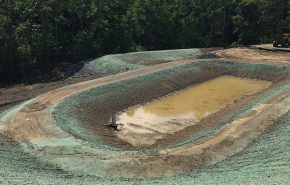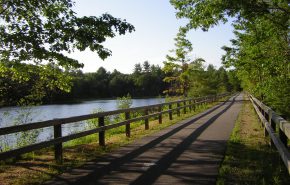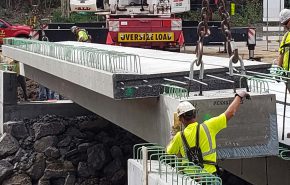Through a wide range of flood mitigation projects, local GAI teams are helping rebuild areas of West Virginia that were hit by devastating floods in June 2016. Project leaders Kenneth Kinder, PE, CFM and Shaun Long, PE, DBIA describe GAI’s work and what it’s like to help restore homes and services in their own communities.
Torrential rains battered areas of West Virginia on June 23, 2016, causing massive flash flooding that devastated several communities—destroying homes and infrastructure and causing 23 fatalities. Now, a multidisciplinary team of GAI specialists—many of them area residents with ties to the affected communities—are helping the region rebuild.
“It is very fulfilling work—the hope is that you could play just a little part in bringing West Virginia back and making it a place that even more people want to come visit.”
Several flood mitigation projects involving GAI’s Energy and Infrastructure business units and the expertise of company civil engineers, planners, landscape architects, surveyors, and more are currently underway in Kanawha, Logan, Nicholas, and Clay Counties, the City of Richwood, and the Town of Clendenin.
Restoring Homes, Close to Home
GAI’s work in the area comes as Federal Emergency Management Agency (FEMA) funding to perform a range of flood mitigation projects throughout the affected region becomes available through the agency’s Hazard Mitigation Grant Project (HMGP).
Among GAI’s flood mitigation projects is the assessment of homes in flood areas to determine if they are candidates for physical elevation or possible reconstruction, and then leading the resulting home elevation or reconstruction.
Through this process, GAI dispatches a team to evaluate damaged homes to determine if they are structurally sound enough to be physically elevated above the 100-year flood elevation. If a home does not meet the criteria for physical elevation, it can become a reconstruction project, which means the house is demolished and completely rebuilt at a higher elevation. Currently, approximately 57 homes are undergoing evaluation, elevation, or reconstruction through GAI’s work.
![]()
Powering Redevelopment and Improved Community Services
GAI has been retained by Logan County to survey and analyze its affected areas to help establish that FEMA’s flood maps accurately reflect the floodplain. This type of work assembles a range of data to support a Letter of Map Revision, or LOMR. Kenneth Kinder, PE, CFM, Engineering Manager in GAI’s Energy/Power Generation market, is heading up this work. Kinder’s parents live in hard-hit Clay County.
“The LOMR process should effectively revise FEMA’s flood maps to include fewer homes in the flood zone,” said Kinder. “This has the dual benefit of potentially reducing homeowners’ flood insurance rates and increasing areas that are available for redevelopment outside the flood zone.” GAI’s work for Logan also includes performing benefit-cost analyses for upgrades to the county’s sewer system and for replacement and installation of standby generators for the county’s emergency service center.
Reviving Local Attractions
GAI Engineering Technical Leader, Infrastructure/Structures Shaun Long, PE, DBIA—another West Virginia native with family ties in the flood region—is a key player in GAI’s work on the Buffalo Creek and Gauley (BC&G) Railroad and Trail project for Clay County. The BC&G is an 18-mile long tourist railroad spur and accompanying recreational trail running from a terminal in Dundon, WV, to the former historic coal and timber town of Widen, WV. Both the railroad and the trail were severely damaged during the flooding.
“Our work includes structural inspections and designing repairs for seven bridges and several miles of railroad,” said Long. “We’re making inventories of the assets that were affected, and at the end of the BC&G project we’ll be putting together engineering documentation to support reconstruction of bridges, culverts, embankments, walls, and the trails that were washed away in the flood.”
![]()
Doing Their Best to Bring West Virginia Back
“Civil engineering has a lot of different components to it, but what is most rewarding to me are projects where I really get to see some development in the community and help rebuild homes for people,” said Kinder.
Long agrees: “It is very fulfilling work—the hope is that you could play just a little part in bringing West Virginia back and making it a place that even more people want to come visit.”
Contact Kenneth Kinder or Shaun Long for more information about how GAI can assist with civil engineering and planning projects in your municipality.
![]() Kenneth Kinder, PE, CFM has more than 15 years of experience in a variety of civil engineering projects. Specializing in design and permitting, Kenneth’s areas of expertise include civil site design, erosion and sediment control, stormwater management, hydraulic modeling and hydraulic design, floodplain management and floodplain permitting, coal and limestone quarry permitting, and solid waste landfill design.
Kenneth Kinder, PE, CFM has more than 15 years of experience in a variety of civil engineering projects. Specializing in design and permitting, Kenneth’s areas of expertise include civil site design, erosion and sediment control, stormwater management, hydraulic modeling and hydraulic design, floodplain management and floodplain permitting, coal and limestone quarry permitting, and solid waste landfill design.
![]() Shaun Long, MS, PE, DBIA has more than 14 years of civil engineering experience in addition to several years of project management experience. Shaun’s areas of expertise include bridge inspection, design, analysis, plan preparation, and a thorough knowledge of transportation system evaluation, transportation planning, and traffic analysis. Shaun has been involved in inspecting more than 350 bridges along the eastern United States.
Shaun Long, MS, PE, DBIA has more than 14 years of civil engineering experience in addition to several years of project management experience. Shaun’s areas of expertise include bridge inspection, design, analysis, plan preparation, and a thorough knowledge of transportation system evaluation, transportation planning, and traffic analysis. Shaun has been involved in inspecting more than 350 bridges along the eastern United States.


